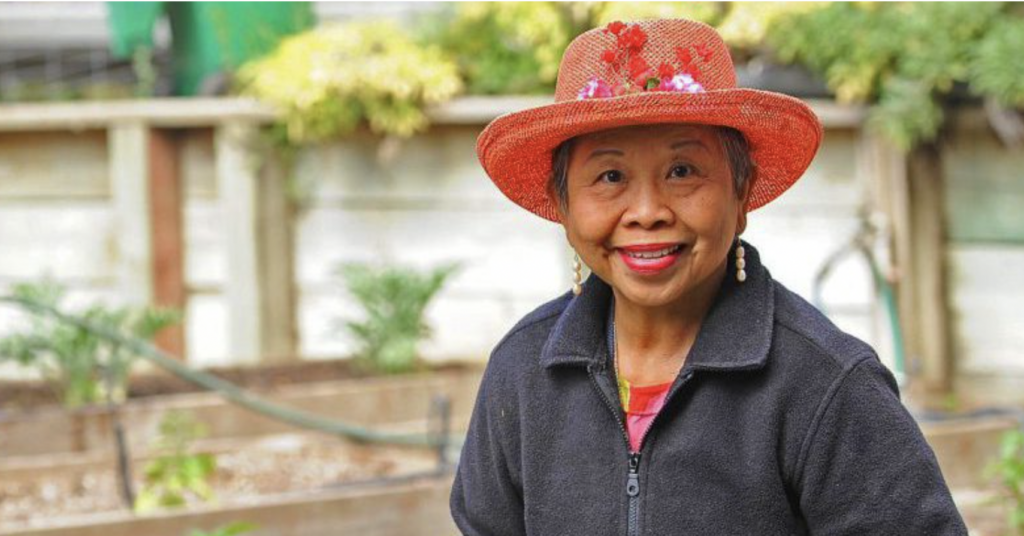
Nature Based Therapy for Seniors
The Healing Power of Nature
Let’s start with the butterflies—they were all over the Masonic Homes’ Covina campus this spring. “I’ve lived in this area all my life and I’ve never seen it like this,” says Sandy Fahey, the skilled nursing administrator at the Covina community. Southern California experienced a rare Painted Lady migration this year, and with it came a flood of color and motion.
As Fahey sees it, those butterflies—along with the flowers and plants they’re attracted to—are more than just decorative. They are downright therapeutic. Beyond the simple pleasure of breathing in fresh air or watching a butterfly’s fluttering path, it turns out that getting out into nature and unplugging from daily life can help reduce stress, combat trauma, and stimulate brain activity—even in those whose brain function is impaired.
That’s the idea behind the soon-to-be-opened memory garden on the Covina campus, an oasis of plants and flowers designed to stimulate sensory memories, which can help to anchor people for whom memory and recall are declining. That sort of calming effect can help improve residents’ focus and peace of mind—a way to be present in the moment, even if the moment can at times feel unclear.
NATURE AS THERAPY
Fahey is one of many acolytes of the nature-as-therapy movement. She described a recent nursing experience with a patient suffering from dementia who often became agitated. “We had gardenias planted outside, and almost the minute I brought her outside and sat with her there, she would become very calm and stay calm for a couple of hours,” she says.
John O’Hara, a horticultural therapist who works with Masonic Homes residents at the Union City campus, has also seen the effects of such gardens on dementia patients. “A client can be totally disoriented, but then tell me everything about the garden,” he says. “She can’t remember my name, but she can show me what’s growing, changing, and progressing in the dirt.”
O’Hara drives around in a van full of horticultural supplies for a consultancy called Special Plants, Special People. The patients he visits plant and tend to the flowers and bushes he provides, while he observes their reactions. Using plants as a tool, he’s able to build a connection with residents who can have trouble developing new relationships. “We build a connection solely on our love of plants—that’s the magic of our time together,” he says.
GO OUTSIDE
But the healing effects of the out-of-doors aren’t confined to those suffering from memory loss, according to Lisa Goodwin, senior director at the Masonic Center for Youth and Families (MCYAF) in Covina. She describes her concerns for youth who are now spending most of their time indoors. “With ready access to endless indoor entertainment from computers, video games, and TV, children have more and more enticements to stay inside. They are missing out on the many enjoyable and healthy benefits of contact with nature.” Unfortunately, as American culture has largely moved indoors and the magnetic pull of screen time has become so profound, it is estimated that just 7 percent of children’s time is now spent outdoors. That reflects such minimal time in direct contact with nature – which evidence shows leads to increased mental health and psychological development. Nature is an effective yet currently underutilized stress reliever. The problem has been described in the popular press as “nature deficit disorder.” The solution is simple: Go outdoors.
“Being in nature even for 15 or 30 minutes can get the mind to break patterns,” Goodwin says. And that counts just as much if you’re taking a walk down a trail as it does scaling peaks at Yosemite. For her, seeking out nature creates a new mindset, involving a conscious attempt to join your physical self to the natural world. Goodwin points to our tendency to ruminate on negative thoughts. “Let’s say you have a fight with your child or spouse, and you’re just repeating it over and over in your mind,” she says. “Then you tell yourself, ‘I’m going to take a walk through a park or down some trails,’ and very soon, what seemed like your whole world is put in perspective.”
Goodwin’s appreciation for outdoor experiences has great application in the clinical work she does at MCYAF. The Covina clinic sits on 33 acres, originally an orange orchard, that has been transformed into a peaceful oasis. “Our clinic works with many kids impacted by horrific experiences like abuse, although many of our clients are simply struggling with everyday challenges of adolescence” she says. “Regardless of their past or their problems, when they arrive in this tranquil setting, you can just feel their relief.” Therapists sometimes hold their appointments with these young people outdoors, on a walk of the grounds or while shooting hoops. “It doesn’t always feel natural for a child to talk about their feelings in an office,” Goodwin says. “But get them active outside, and they notice the butterflies and hear the birds, and start to connect their thoughts and feelings to their senses and their bodies, where trauma is locked.”
For the residents and clients in Covina, exploring nature can be as simple as strolling the grounds or tending to a peaceful garden. But that may be enough to make a difference. As the garden evolves with the seasons, it serves as a reminder to go outside and stay present for each transformative moment—not only when the butterflies are here, but all year long.
To inquire about our memory care services or to tour the facilities, call (888) 466- 3642
